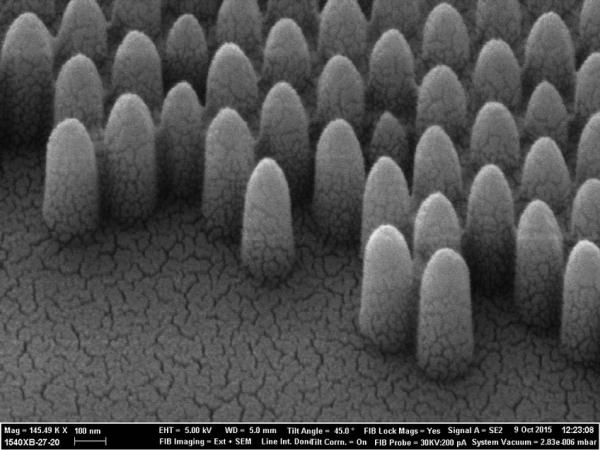
Date: 22 January 2016
A revolutionary new type of smart window could cut window-cleaning costs in tall buildings while reducing heating bills and boosting worker productivity. Developed by University College London (UCL) with support from EPSRC, prototype samples confirm that the glass can deliver three key benefits:
- Self-cleaning: The window is ultra-resistant to water, so rain hitting the outside forms spherical droplets that roll easily over the surface – picking up dirt, dust and other contaminants and carrying them away. This is due to the pencil-like, conical design of nanostructures engraved onto the glass, trapping air and ensuring only a tiny amount of water comes into contact with the surface. This is different from normal glass, where raindrops cling to the surface, slide down more slowly and leave marks behind.
- Energy-saving: The glass is coated with a very thin (5-10nm) film of vanadium dioxide which during cold periods stops thermal radiation escaping and so prevents heat loss; during hot periods it prevents infrared radiation from the sun entering the building. Vanadium dioxide is a cheap and abundant material, combining with the thinness of the coating to offer real cost and sustainability advantages over silver/gold-based and other coatings used by current energy-saving windows.
- Anti-glare: The design of the nanostructures also gives the windows the same anti-reflective properties found in the eyes of moths and other creatures that have evolved to hide from predators. It cuts the amount of light reflected internally in a room to less than 5 per cent – compared with the 20-30 per cent achieved by other prototype vanadium dioxide coated, energy-saving windows – with this reduction in ‘glare’ providing a big boost to occupant comfort.
A scanning electron miscroscope photograph shows the pyramid-like nanostructures engraved onto glass: at 200nm they are 100 times smaller than a human hair. Controlling the surface morphology at the nanoscale allows scientists to tailor how the glass interacts with liquids and light with high precision.
This is the first time that a nanostructure has been combined with a thermochromic coating. The bio-inspired nanostructure amplifies the thermochromics properties of the coating and the net result is a self-cleaning, highly performing smart window, said Dr Ioannis Papakonstantinou of UCL.
The UCL team calculate that the windows could result in a reduction in heating bills of up to 40 per cent, with the precise amount in any particular case depending on the exact latitude of the building where they are incorporated. Windows made of the ground-breaking glass could be especially well-suited to use in high-rise office buildings.
Dr Ioannis Papakonstantinou of UCL, project leader, explains: It’s currently estimated that, because of the obvious difficulties involved, the cost of cleaning a skyscraper’s windows in its first 5 years is the same as the original cost of installing them. Our glass could drastically cut this expenditure, quite apart from the appeal of lower energy bills and improved occupant productivity thanks to less glare. As the trend in architecture continues towards the inclusion of more glass, it’s vital that windows are as low-maintenance as possible.
Discussions are now under way with UK glass manufacturers with a view to driving this new window concept towards commercialisation. The key is to develop ways of scaling up the nano-manufacturing methods that the UCL team have specially developed to produce the glass, as well as scaling up the vanadium dioxide coating process. Smart windows could begin to reach the market within around 3-5 years, depending on the team’s success in securing industrial interest.
Dr Papakonstantinou says: We also hope to develop a ‘smart’ film that incorporates our nanostructures and can easily be added to conventional domestic, office, factory and other windows on a DIY basis to deliver the triple benefit of lower energy use, less light reflection and self-cleaning, without significantly affecting aesthetics.
Professor Philip Nelson, Chief Executive of EPSRC said: This project is an example of how investing in excellent research drives innovation to produce tangible benefits. In this case the new technique could deliver both energy savings and cost reductions.
A 5-year European Research Council (ERC) starting grant (IntelGlazing) has been awarded to fabricate smart windows on a large scale and test them under realistic, outdoor environmental conditions.
A smart glass prototype developed by the UCL team. The dark areas are decorated with the nanostructures, which significantly suppress reflections. They also repel water forcing it to form nearly spherical droplets and preventing it from wetting the surface of the glass. The UCL logo is made of untreated glass and appears significantly more reflective compared with its surrounding region.
 600450
600450

.jpg)
.jpg)









Add new comment